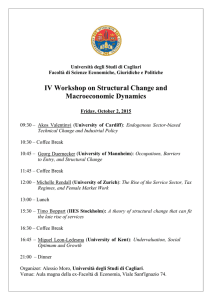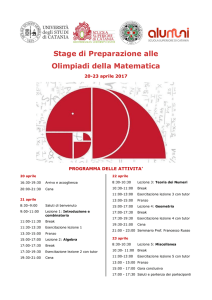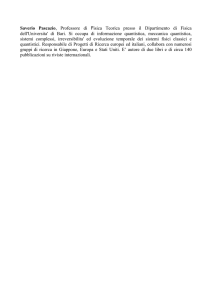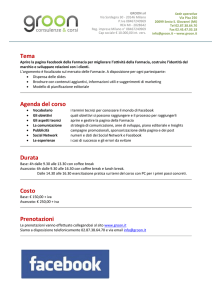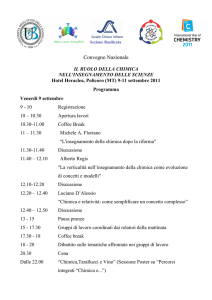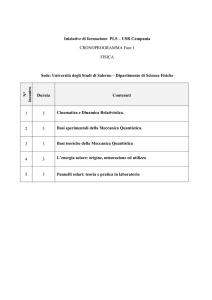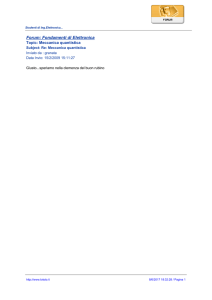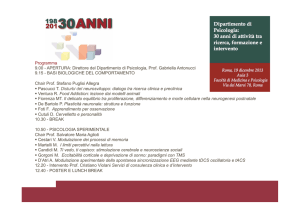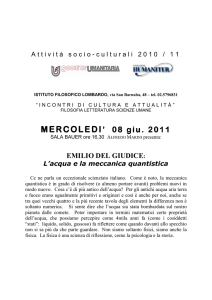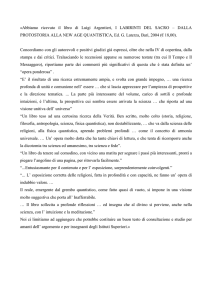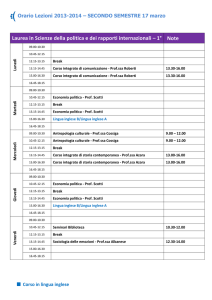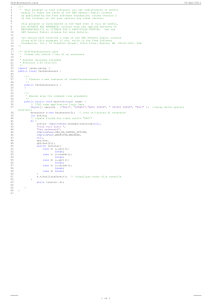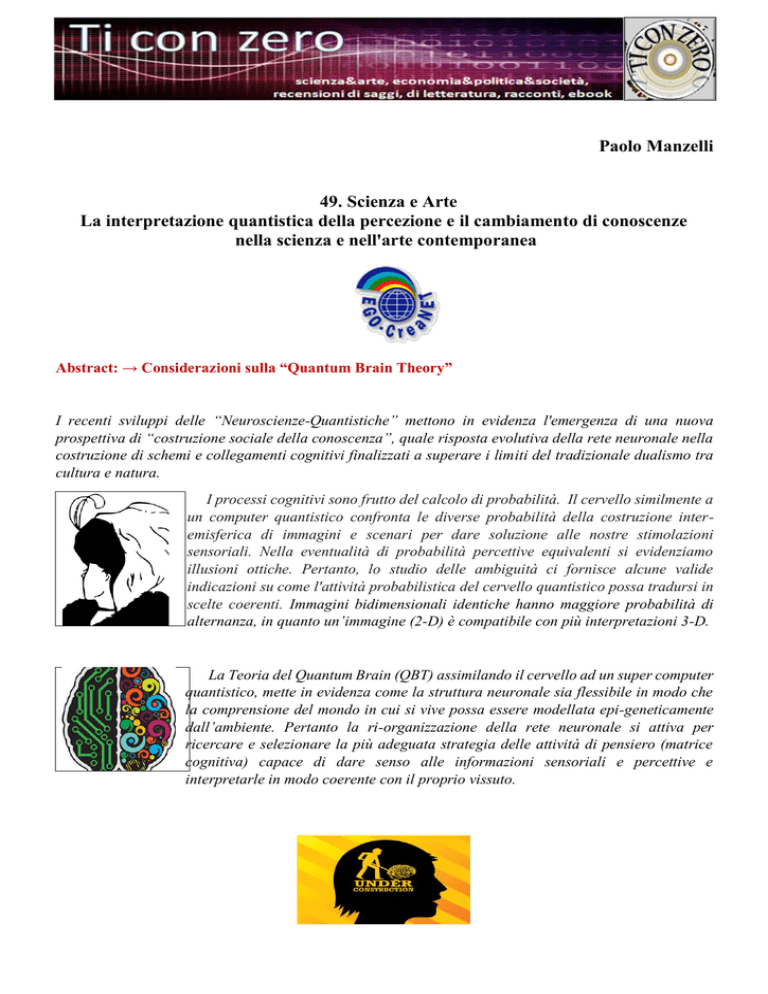
Paolo Manzelli
49. Scienza e Arte
La interpretazione quantistica della percezione e il cambiamento di conoscenze
nella scienza e nell'arte contemporanea
Abstract: → Considerazioni sulla “Quantum Brain Theory”
I recenti sviluppi delle “Neuroscienze-Quantistiche” mettono in evidenza l'emergenza di una nuova
prospettiva di “costruzione sociale della conoscenza”, quale risposta evolutiva della rete neuronale nella
costruzione di schemi e collegamenti cognitivi finalizzati a superare i limiti del tradizionale dualismo tra
cultura e natura.
I processi cognitivi sono frutto del calcolo di probabilità. Il cervello similmente a
un computer quantistico confronta le diverse probabilità della costruzione interemisferica di immagini e scenari per dare soluzione alle nostre stimolazioni
sensoriali. Nella eventualità di probabilità percettive equivalenti si evidenziamo
illusioni ottiche. Pertanto, lo studio delle ambiguità ci fornisce alcune valide
indicazioni su come l'attività probabilistica del cervello quantistico possa tradursi in
scelte coerenti. Immagini bidimensionali identiche hanno maggiore probabilità di
alternanza, in quanto un’immagine (2-D) è compatibile con più interpretazioni 3-D.
La Teoria del Quantum Brain (QBT) assimilando il cervello ad un super computer
quantistico, mette in evidenza come la struttura neuronale sia flessibile in modo che
la comprensione del mondo in cui si vive possa essere modellata epi-geneticamente
dall’ambiente. Pertanto la ri-organizzazione della rete neuronale si attiva per
ricercare e selezionare la più adeguata strategia delle attività di pensiero (matrice
cognitiva) capace di dare senso alle informazioni sensoriali e percettive e
interpretarle in modo coerente con il proprio vissuto.
→ La fisica quantistica quantistica, fin dalle sue origini (Principio di Indeterminazione - 1927) ha
posto in evidenza come le modalità di osservazione stessa modificano la conoscenza probabilistica
della realtà. Di conseguenza quando cambiano le idee con cui si procede alla osservazione, allora
anche quanto viene osservato può essere modificato proprio in quanto sussiste una stretta relazione
tra pensiero ed osservabilità percettiva.
A tal proposito Rudolf Arnheim nel suo libro Il pensiero visivo scrive:
“[...] le operazioni cognitive chiamate pensiero non sono privilegio dei processi mentali posti al di sopra
e al di là della percezione, bensì gli ingredienti essenziali della percezione stessa”.
La “neurologia quantistica” tratta come un unico procedimento probabilistico di decodifica/codifica la
costruzione cerebrale dell'immagine nel quale l’attività percettiva e il pensiero interagiscono entrambi nella
risoluzione della probabilità quantistica: pertanto, i nostri pensieri influenzano quanto vediamo e viceversa.
Ad esempio, l'idea che naturalmente la luce influenza la nostre scelte su la percezione di concavo o
convesso. Inoltre, un atteggiamento positivo del pensiero puo modificare il decorso di una malattia.
Ogni immagine visiva in evidenza come la percezione del rapporto delle informazioni relative alla
figura e sfondo vengano a caratterizzarsi per tramite le probabilità di “coesistenza e separabilità”, che
permettono di mettere a fuoco e porre attenzione ad una situazione percettiva. I rapidi movimenti oculari
(saccadi) corrispondono a programmi statistici per i quali la visione dipende da un processo a più livelli di
scelta ed elaborazione quantistica delle informazioni.
Se infatti non esistesse nessuna forma di contrasto tra le probabilità di informazione di grandezza,
forma e colore, la figura risulterebbe del tutto impercettibile. Della non facile distinzione della probabilità
di percezione sulla figura rispetto allo sfondo trae agevolazione il “mimetismo”.
Alcuni rapporti equivalenti tra le probabilità di informazione tra figura e sfondo, generano illusioni
ottiche. Inoltre, nella dinamica della percezione il cervello completa ovvero annulla i contorni della figura
per permettere la stabilità percettiva delle informazioni dinamiche provenienti da varie angolature e varie
situazioni dinamiche.
Pertanto, iI nostro cervello, agendo quantisticamente, “scommette” sulla probabilità che le cose stiano
in un certo modo e quindi produce scenari percettivi che creano il crash dell’incertezza nella previsione di
ciò che percepiamo, a volta facendoci cadere nella trappola delle illusioni ottiche.
Il neurologo Semir Zeki, tra i primi neuroscienziati ad occuparsi di Neuro-estetica specificamente
dedicata alla intuizione artistica, ritiene che il pensiero che pervade la pittura moderna sia assimilabile ad
una scienza applicata del cambiamento delle funzioni cerebrali, che tendono ad interpretare e comunicare
il rinnovamento della intuizione artistica.
Lo scienziato, come l'artista, non conosce quale sia l'esito finale della sua opera, che infatti è il
frutto di cari tentativi. Ciò avviene anche nella percezione che confronta diversi scenari probabili fin
quando si ritiene corretta la previsione di ciò effettivamente vediamo. Certamente ciò che osserviamo
è più complesso di ogni possibile scenario costruito dal cervello come previsione delle sole interazioni
materia-materia dal nostro cervello.
Semir Zeki sottolinea inoltre come i grandi artisti (vedi ad es. il Sorriso della Gioconda di Leonardo
da Vinci) sappiano sfruttare le ambiguità percettive per dar vita a una forte attrazione empatica della propria
opera.
Il cervello non elabora le immagini nella loro oggettività e interezza, ma le genera come organizzazione
di probabilità, le quali poi vengono sincronizzate dal ricorso alla memoria che ne determina la scelta più
ottimale. Le probabilità illusorie non sono solo quelle ottiche ma vi sono anche quelle uditive, tattili,
olfattive e pertanto, purtroppo, occorre considerare attentamente le illusioni di ordine cognitivo che ci
allontanano da una più coerente costruzione della realtà percepita e conosciuta.
In sintesi, la ”Teoria del Quantum Brain” (QBT), indica che il cervello “non vede ma prevede”
scenari probabilistici sulla base di una innata tendenza alla preveggenza del futuro. Sappiamo quindi
che il Cervello Quantistico costruisce attivamente scenari di probabilità percettiva. Pertanto, la
percezione visiva consiste in una rappresentazione virtuale che descrive la probabilità delle possibili
future interazioni tra il nostro corpo e l'ambiente che ci circonda.
Questa concettualità finalizzata alla previsione è stata il punto di forza dell’alchimia e dell’astrologia
dei tempi antichi, ma ha trovato un suo limite nel riduzionismo della concezione meccanicistica della
scienza accademica contemporanea, che pertanto è rimasta cristallizzata in una struttura cognitiva basata
sulle limitazioni riduttive di indole “meccanica” che sono rimaste strettamente correlate alla unicità della
geometria di uno spazio-tempo Euclideo.
La QBT conduce a dare sviluppo un contesto innovativo e dirompente dove la conoscenza non può più
essere considerata come una sequenza lineare di scoperte della realtà naturale pre-esistente, come se essa
fosse regolata da logiche di causa ed effetto, ma invece come una costruzione probabilistica che si conforma
con la ristrutturazione quantistica della rete neuronale quale risposta “epigenetica-evolutiva” alle rinnovate
necessità del cambiamento biologico e mentale.
La Teoria del Quantum Brain (QBT), superando la arbitraria suddivisione tra soggetto e oggetto della
percezione, genera pertanto una nuova prospettiva nell'ambito del costruttivismo cognitivo iniziato da Jean
Piaget (1936), infatti la QBT delinea come, lo sviluppo creativo delle attività cerebrali, non sia più inteso
come crescita lineare della conoscenza che si sviluppa dal concreto all' astratto, partendo dall' osservazione
della natura. Viceversa, lo sviluppo contemporaneo delle conoscenze, interpretabile sulla base della QBT,
viene ad essere il risultato concreto della ristrutturazione quantistica della rete neuronale che fa seguito alla
rottura delle precedenti necessità di adattamento biologico e mentale. Pertanto, nella attuale situazione di
crisi strutturale, la conoscenza tende ad essere rigenerata dalla incertezza e dal rischio effettivo di
sopravvivenza della vita e della sua bio-diversità, in risposta alla progressiva degenerazione dell'ambiente
che è stata determinata da una visione lineare e meccanica dello sviluppo.
Partendo dalle precedenti considerazioni sul cambiamento quantistico-neuronale del costruttivismo
cognitivo, potremo infatti superare creativamente l'ormai obsoleto riduzionismo cognitivo delle logiche
lineari di crescita del vecchio modello dello sviluppo produttivo-industriale, potenziando la creatività
concettuale e la innovazione operativa, già ad iniziare dal progetto BREAK -CREATIVE EUROPE 2015,
creando nuove modalità ed attività in favore della costruzione di un “pensiero circolare ad elevata
responsabilità sociale”, ed agendo nel valorizzare l’espressione scientifica e artistica della creatività
quantistica, anche mediante l’utilizzazione delle emergenti tecnologie di comunicazione della Realtà
Aumentata.
Questa strategia di costruzione cognitiva promossa dal programma BREAK / di EGOCREANET e
collaboratori, ci renderà capaci di definire e diffondere una nuova visione prospettica dello sviluppo
concettualmente “olistico”, determinante per un futuro migliore e più cosciente.
Sulla base queste considerazioni e obiettivi della “Quantum Brain Theory”, ricerchiamo partner
internazionali e sostenitori interessati allo sviluppo del Progetto Europeo dal titolo “BREAK” finalizzato a
favorire una pausa di riflessone sia nell' arte che nella scienza quantistica, tale che consenta di ripensare e
di riorganizzare i processi cognitivi sulla base di una elevata responsabilità' della scienza e della
innovazione sociale ed economica contemporanea.
BIBLIO ON LINE
QuantumBrain and Art: http://www.caosmanagement.it/52-quantum-art-science-augmented-reality
http://www.egocrea.net/quarte/wpcontent/uploads/2014/07/QUANTUM_BRAIN_Paolo_Manzelli.pdf
Animated ANIMADED ILLUSIONS: http://www.moillusions.com/
Optical Illusions : http://michaelbach.de/ot/
Semir Zeki - Neuro-estetica: http://www.c-arte.it/uk/htm/eventi/11/w_on_w/w_on_w.htm;
http://www.neuroestetica.it/
Quantum Brain and Nanosynapses:
http://www.nanopaprika.eu/forum/topics/quantum-brain-and-nano-synapses
Cervello Arte e Scienza Quantistica:
http://www.fisicaquantistica.it/miscellanea/cervello-arte-e-scienza-quantistica
QUARTE: http://www.caosmanagement.it/n77/art77_02.php
17 aprile 2015
Codice ISSN 2420-8442
Addendum
--SEARCH FOR PARTNERS TO DEVELOP A RRI HORIZON 2015 PROGRAM
Invitation by EGOCREANET ( NGO-Italy) :[email protected];
see the call on RESEARCH & INNOVATION RESPONSIBILITY in :
Type of action: Coordination and Support Actions.
http://ec.europa.eu/research/participants/portal/desktop/en/opportunities/h2020/topics/2419-issi-1-2015.html
Preliminary Proposal presented by NGO of R&D at the University of Florence.
N.B:
→ Egocreanet is a NGO -Italian based organisation, that promotes citizen science and responsible transdisciplinary projects around
the world. → Egocreanet promoting the “Break “Project look forward to find partners that would ameliorate a successful interactivity
of science and innovation for citizen in order that the involvement of ordinary people will be more strongly collaborate in
responsible research and innovation.
PRELIMINARY APPROACH OPEN TO A DIALOG (between partners) .
1.Title (Acronym + Full title)“BREAK “ + /“ Break Barriers of “Social Responsibility of Science and Art ”) .
"Break", will be a European program of events open to a pause for reflection on the need 'to
boost creativity socially responsible of Science and Art.
Scope:
Break Program will organise publicexhibitions and participatory events throughout the whole of
Europe to engage citizens in advanced science understanding . Break Program Exhibitions and
participatory events will be interactive and adapted to local/regional conditions (i.e.: use of
relevant case-studies) and shall take place in the local languages. Exhibits shall provide material
for dissemination for dissemination of Responsibility Research Innovation Toolkit . Break
Program will make use of existing multimedia and other relevant technology (e.g.: social media,
virtual reality, scenarios, gaming, etc.) and shall employ inclusive participatory techniques to
engage with multiple publics (children, youth, women, adults, and other relevant stakeholders).
2.Teaser:
Rethinking Science : scientific research has changed the world.
Now it needs to change itself with an higher responsibility.
→ The Break Project would enhance innovative scenarios of science with and for society , aiming to for improve new ideas , strategies and
management for enhancing social creativity potential of citizen in Europe. The above goal will be implemented of about the fast-technological
modernization of communication of advanced science and technology , looking to favor a more conscious and responsible foundations for
improving human values in science research & innovation more adapted to building an open participatory future knowledge society.
3. GOAL .
Science and innovations are often hidden behind simple buttons and patterns touchable with a finger. The Project would BREAK Barriers aiming
to improve Social responsibility of science . A principal goal will be to make explicit for young people to overcome the existing barriers between
generation through for developing a sense of conscious responsibility of the role of science in civilization' of contemporary era. As a matter of
facts often emerging technology contains high levels of complex science hidden behind the touch of a finger on a screen or press a button, causing
difficulties in advanced science knowing for youth and in general for normal people. . So that the stimulus response behavior , activated by the
touch of your fingers on screens or buttons, could generate high levels of un-consciousness. For example, the natural activity of sharing emotions
developed by the "mirror neurons", may be excluded using the modern ,ITC tools of a distance education These and other considerations involve
a careful reflection on what systematically today tends to increase the irresponsibility of people living in a high technological-era. The project
Break would develop in Europe various cultural activities about science popularization and dissemination to counter the continuing gap of
knowledge about advanced scientific discoveries. In that way the Break project may be the basis to strenght the knowledge of excellence in
science and to advance the contemporary creativity of people to meet the demand and the expectation of understanding as it is necessary to
improve a more disruptive and transformational innovation for improving a responsible scenario of social change . Therefore EGOCREANET
offers to scientists and artists to participate in the Horizon project entitled "BREAK" to favor a responsible creativity focused to encouraging a
responsible contribution to overcoming the contemporary economic and social crisis and rethinking the future trends of knowledge in Europe.
4.Aims and Basic information
Premise: As we may see, till today technology have advanced quickly and significantly over the past two centuries. Often the “best” technology
one day rapidly becomes “outdated” the next and is conveniently replaced with something “better” for made a lot of work both intellectual and
manual simply pushing with a click of some buttons. It seems that nothing can stop humans’ desire for making more and more simplify
technological advancements to substitute human work .
But what happen about human consciousness and social responsibility ?
What about “human values and ethics ”?Has knowledge society advanced over the recent years?
5.Description of the research and reports of the project
RRI- BREAK Project first proposal by EGOCREANET- 02 FEB .-2015:
The BREAK project aim to better incorporate scientific knowledge societal values, needs and expectations in research and innovation. Actual
RRI goals are evolving in a way that the future deliberate focus of research and the products of innovation will be more and better oriented to
achieve a social or environmental benefit of RRI European strategy
6.) Tasks
a) The consistent, ongoing involvement of society as useful to assessing and effectively prioritizing social, ethical and environmental impacts,
risks and opportunities, both now and in the future, along-side the development of future knowledge economy.
b) Develop conscious creativity to anticipate and manage problems and opportunities which are also able to adapt and respond quickly to
changing both environment and knowledge for a more secure and clean living in Europe.
c) Identify and implement the best systemic organizational and managerial approaches to increase the public responsible participation to
remove obstacles and barriers to science & technology foresight to growth social benefits for all generations .
7.Description of the activities and teaching materials of the project
The overall contribution of the Break project would be focused on the following activities:
a) develop an in-depth understanding RRI relationships with societal problems ethical issues and dilemmas in conducting responsible research
in science with and for society ; b) provide of a set of recommendations and good practices, to be adopted by researches and managers
teachers and students in a easy approach for including a large participation of citizen. c) developing and the web-community and to create a self
sustaining ‘Responsible Creativity Observatory’ serving as a community portal and providing free access to all outputs of the project.
8.RRI- Tool-Kit: Description of teaching materials, lesson plans, learning resources
The RRI Toolkit will be an innovative and creative set of tools comprising practical digital resources and actions aimed at raising awareness,
training, disseminating for implementing the RRI state of the art.
Scientific issues :
BREAK partnerschip will organise one great Festival of science as a public exhibitions and participatory events throughout to engage citizens
(children, youth, women, adults, and other relevant stakeholders) in advanced science and technology to enhance and improve an higher
knowledge dissemination integrated with an conscious sense of responsibility .
As EGOCREANET , we propose the following topics to organize with the partners of the project and stakehoders , some , conferences,
workshpos and production of educational materials for the TOOL KIT or by other modes of diffusion and implementation of the project, aimed to
encourage the development of social and cultural responsibility science and art in Europe.
Proposed themes:
1 “Neuroscience social responsibility” in order to promote creativity and health to allow the welfare of citizens.
2) “Synthetic Biology”: Scientific and ethical issues of creating new life
What rational and irrational fears are at stake when the human being becomes the creator of new life forms created in the laboratory?
3) Topics of the frontier of “innovation in medicine” concerning the application of stem cells and nanotechnology
4) Trans-disciplinay “nano-science and future emerging technologies”.
5) “Circular economy”, to extend lifecycle thinking in eco- innovattion of design of production for better end-of-life recovery,improving the
biosphere safely and to minimise energy and primary products use.
N:B: The list of the effective Working Plan in science topics will be chosen by the-Partnerhip. - (Thus these topics will take-up and further
develop the information and training material produced by the RRI Toolkit developed by the Seventh Framework Programme project RRI
Toolkit.)
8.) List of projects and reports to be taken in consideration
1)- RRI-TOOLS :http://www.rri-tools.eu/; 2)http://www.euroscientist.com/science-in-society/;
3) Gender Diversity:http://www.fraunhofer.de/de/leistungsangebot/forschung/gender-diversity/kontakt-fraunhofer-genderdiversity.html;
4) (FRRIICT):http://www.oerc.ox.ac.uk/projects/frriict; https://renevonschomberg.wordpress.com/,
5) Progress: http://www.progressproject.eu/more-rri-resources/
6) RESPONSIBLE:..: https://blogs.nottingham.ac.uk/makingsciencepublic/2014/02/24/responsible-innovation-great-expectations-greatresponsibilities/,
7) Biology Responsiblity: http://synbio.ku.dk/about_the_unik_synthetic_biology_centre/boards/maja_horst/;
BREAK Project (*) . Full title:
- BREAK - BARRIERS for IMPROVING “Social Responsibility of Science”.
“Taking responsibility for future choices provides a reciprocal exchange of ideas of science
and tech as the basis for a common trust in humanity.”
Letter of Intent :
This LoI is a Template for Community Partners signed as a simple preliminary gentlement agreement to participate in the project BREAK as
partner
(Name of Organization : )
The (Name of Scientific or Artist or Organization),
intend to participate as Partner in the project (Achronim of Project : BREAK ) that it is proposed by :
(Name of the Promoter : EGOCREANET :ONG -Florence -IT) )
See statute of the ONG (in Italian ) in: http://www.egocrea.net/quarte/wp-content/uploads/2014/05/Registrazione-ONG-ONLUS-2014-05-09..pdf
The (Partner- Organization ) will provide to an open collaboration with EGOCREANET to develop the project proposal till the date of its
submission.
Date/ and Signature of Representative.
(Add the short profile of the partner's Organization)
_______________________________________
Name of Scientific / Artist or Organization
name of Representative:
Name of Contact Person:
Phone:_____________________Cellular:__________________,Fax:__________________
Email:
Address:
Website:
----------------------------------------------------------------------(*)- see the call on RESEARCH & INNOVATION RESPONSIBILITY in :
http://ec.europa.eu/research/participants/portal/desktop/en/opportunities/h2020/topics/2419-issi-1-2015.html
NB: To date, ( 14thFEB.2015) the project partners sustaining the BREAK proposal are :
1) EGOCREANET (NGO) c-o Business incubator -University of Florence (IT) ; http://www.edscuola.it/lre.html ;
2) Departamento de Educación de la Theory, Facultad de Ciencias de la Educación y Philosophy,Institute of Educatiion Creativity, Avda. Blasco
Ibañez, nº 30, (ES) Valencia; Contact: prof. Mª Carmen Moreno Bellver, telf. 96/386 4736, email. : <[email protected]> in cooperation
with the City of Science of Valencia (ES)
3) The Museum of Chemistry Primo Levi University of Rome "La Sapienza" (IT): http://www.chem.uniroma1.it/strutture/museo,
http://www.chem.uniroma1.it/museo/; Contact: Prof.Luigi Campanella .mail: <[email protected]>
4) Science for Promotion of Science in Serbia: http://www.cpn.rs/?lang=en;Contact Person : Divna Vuckovic <[email protected]>

